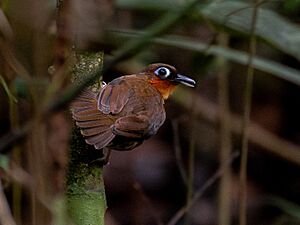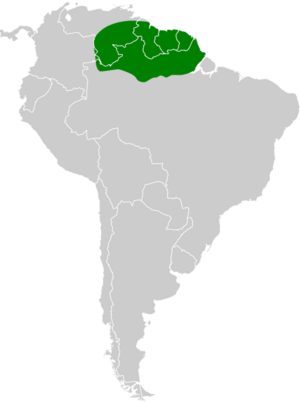Rufous-throated antbird facts for kids
Quick facts for kids Rufous-throated antbird |
|
|---|---|
 |
|
| Conservation status | |
| Scientific classification | |
| Genus: |
Gymnopithys
|
| Species: |
rufigula
|
 |
|
The rufous-throated antbird (scientific name: Gymnopithys rufigula) is a type of bird found in South America. It belongs to a family of birds called "typical antbirds" (Thamnophilidae). You can find this bird in countries like Brazil, French Guiana, Guyana, Suriname, and Venezuela.
Contents
About the Rufous-throated Antbird
This bird is known for its bright, reddish-orange throat. It lives in the warm, wet forests of the Guianan Shield region. The rufous-throated antbird is a special bird because it often follows swarms of army ants to find its food.
What Does the Rufous-throated Antbird Look Like?
The rufous-throated antbird is a small bird, about 11.5 to 14 centimeters (4.5 to 5.5 inches) long. It weighs between 26 and 32 grams (about 1 ounce).
- Males: Adult males have a brownish-black forehead and a blue patch of bare skin around their eyes. Their back and rump are olive-brown. Their wings and tail are dark yellow-brown. The most noticeable part is their rufous-chestnut (reddish-brown) cheeks and upper throat. Their lower throat and upper chest are cinnamon colored.
- Females: Adult females look similar to males but are a bit duller in color. They have a cinnamon-colored patch on their back that is usually hidden.
There are three slightly different types, or subspecies, of the rufous-throated antbird. They mostly differ in how pale or dark their throats and bellies are.
Where Do Rufous-throated Antbirds Live?
These birds live in the Guianan Shield, a region in northeastern South America.
- The most common type is found in eastern Venezuela, French Guiana, Guyana, Suriname, and northern Brazil.
- Other types are found in specific parts of southern Venezuela.
They prefer to live in humid, lowland, and foothill evergreen forests. They usually stay close to the ground in the forest undergrowth. They rarely go into open areas or cross roads and streams. These birds are typically found below 900 meters (3,000 feet) in elevation. Sometimes, they can be found as high as 1,200 meters (4,000 feet).
How Do Rufous-throated Antbirds Behave?
Rufous-throated antbirds do not migrate. They stay in the same area all year round.
What Do Rufous-throated Antbirds Eat?
The rufous-throated antbird is an "obligate ant follower." This means it almost always follows swarms of army ants. As the army ants march through the forest, they scare out many small creatures like insects and spiders. The antbirds then catch these creatures. They also sometimes eat small lizards.
These birds usually hunt alone, in pairs, or in family groups. They perch close to the ground, usually within 1 meter (3 feet), and then quickly fly down to catch their prey. Sometimes, up to 20 antbirds can be seen following one large ant swarm!
Reproduction and Life Cycle
Rufous-throated antbirds seem to nest at different times of the year depending on the country. In Brazil, they nest mostly from January to April. In Guyana, it's from December to June.
Their nests are small and shaped like cups. They are made from things like dead palm leaves, small twigs, and vine stems. The inside is lined with softer material. Some nests have been found in hollows inside rotten tree stumps. Usually, a female lays two eggs. Both parents help to incubate the eggs during the day, but only the female incubates at night. Both parents also feed the baby birds once they hatch. The young birds leave the nest when they are about 13 to 14 days old.
What Sounds Do Rufous-throated Antbirds Make?
These birds have many different calls. Their main song is loud and sounds like a high, whinnying series of notes. It quickly rises and falls, sounding like "we-whe-whee-HE-He-he'hu'we'we". Some people describe it as starting with high, fluted "weee" notes that speed up and go lower, then become a short rattle before leveling out with low, grating "sree-sree-sree" notes.
They also make calls like a harsh, vibrating "chirr" and abrupt "chup" notes, often in groups of two, three, or four.
Conservation Status: Are Rufous-throated Antbirds Safe?
The International Union for Conservation of Nature (IUCN) has listed the rufous-throated antbird as a species of "Least Concern." This means they are not currently in danger of disappearing.
- They have a very large habitat range.
- Their population size is not fully known, but it is believed to be stable.
- No immediate threats to their survival have been found.
They are considered fairly common throughout the areas where they live. Many of these birds live in protected areas. Their habitat also includes large areas of untouched forest that are not formally protected but are not likely to be developed soon.


